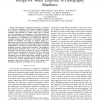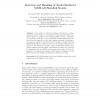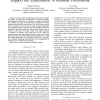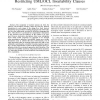MODELS
2015
Springer
8 years 7 months ago
2015
Springer
—Model Driven Engineering (MDE) is essentially based in metamodel definition, model edition and the specification of model transformations (MT) among these. In many cases the d...
MODELS
2015
Springer
8 years 7 months ago
2015
Springer
Model finders enable numerous verification approaches based on searching the existence of models satisfying certain properties of interest. One of such approaches is anATLyzer, a...
MODELS
2015
Springer
8 years 7 months ago
2015
Springer
—Development of high-level supervisory controllers is an important challenge in the design of high-tech systems. It has become a significant issue due to increased complexity, c...
MODELS
2015
Springer
8 years 7 months ago
2015
Springer
—Model-Driven Engineering (MDE) promotes models throughout development. However, models may become large and unwieldy even for small to medium-sized systems. This paper tackles t...
MODELS
2015
Springer
8 years 7 months ago
2015
Springer
—Reuse is essential in modern software engineering, but limited in the context of MDE by the poor availability of reusable models. On the other hand, reusable code artifacts such...
MODELS
2015
Springer
8 years 7 months ago
2015
Springer
Code smells in traditional software artifacts are common symptoms of the violation of fundamental design principles which negatively impact the quality of the resulting software pr...
MODELS
2015
Springer
8 years 7 months ago
2015
Springer
Abstract—This paper presents a novel reverse engineering technique for obtaining real-life event logs from distributed systems. This allows us to analyze the operational processe...
MODELS
2015
Springer
8 years 7 months ago
2015
Springer
—Today’s software is getting more and more complex and harder to understand. Models help to organize knowledge asize the structure of a software at a higher abstraction level. ...
MODELS
2015
Springer
8 years 7 months ago
2015
Springer
Abstract—Model Management addresses the accidental complexity caused by the proliferation of models in software engineering. It provides a high-level view in which entire models ...
MODELS
2015
Springer
8 years 7 months ago
2015
Springer
—The complexity of modern systems (in both, the and hardware domain) raises the need for abstract ions in early stages of the design flow. Such abstract descriptions are provide...




